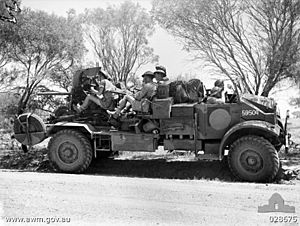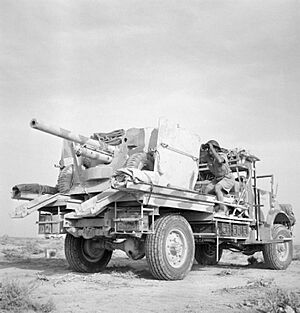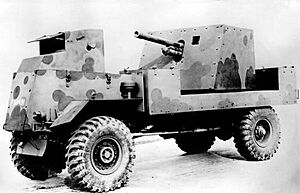Portée (military) facts for kids
Portée (pronounced "por-TAY") is a special way of carrying a gun on a truck. This allows the gun to be fired right from the vehicle, or quickly taken off and used from the ground. This method was often used for anti-tank guns by the British and Commonwealth armies during the Western Desert Campaign in World War II. Today, similar ideas are called "technical" or "gun trucks."
Contents
Early Ideas
US Cavalry
Before World War II, the American army tried something called portée cavalry. This was when horse cavalry (soldiers on horses) were carried in trucks. The idea was to move the horses and riders quickly over long distances using vehicles. Then, when they reached the battle area, the soldiers would get on their horses to fight. However, this system was found to be too complicated and not very useful.
British Army Guns (1939–1943)
During World War II, the British Army used the portée idea for several types of anti-tank and anti-aircraft guns.
2-pounder Anti-Tank Gun
The Ordnance QF 2 pounder was a 40 mm anti-tank gun. It was often put on trucks like the Morris CS8 or Chevrolet WA. These guns could be fired from the back of the truck.
6-pounder Anti-Tank Gun
A larger gun, the Ordnance QF 6 pounder (57 mm), was mounted on bigger trucks like the Bedford QLT or Austin K5. These trucks had a special open back to hold the gun, its crew, and ammunition. Because this gun was heavier and bigger, it was often taken off the truck before battles, more so than the smaller 2-pounder.
Other Guns
The British also mounted other guns using the portée method:
- An Oerlikon 20 mm cannon (an anti-aircraft gun) on a Morris 15 cwt truck.
- A 25 mm Hotchkiss anti-tank gun on a Morris 15 cwt truck.
- A Bofors 37 mm anti-tank gun on a Bedford MW or Morris CS8 truck. This was used by the 106th Royal Horse Artillery during Operation Compass at Beda Fomm.
Deacon
The AEC Mk I Gun Carrier "Deacon" was a more advanced version of the portée, introduced in 1942. It had a 6-pounder gun placed inside a three-sided, armored shield. This shield was on a spinning platform at the back of an armored AEC Matador truck. The gun could only turn a little, so the driver of the Matador truck had to turn the whole vehicle to aim. Deacons were used as a mobile reserve, but by May 1943, they were replaced by American M10 tank destroyers.
Battles and History
Sidi Rezegh
A famous example of portée guns in action happened on November 21, 1941, at Sidi Rezegh in Libya. This was during Operation Crusader. A British unit called J Battery, 3rd Regiment Royal Horse Artillery, used its 2-pounder portée guns to fight back against a German attack by Panzer IV tanks.
Second Lieutenant George Ward Gunn fought bravely with his gun crew until only one gun was left working. The battery commander, Major Bernard Pinney, ordered Ward Gunn to get another gun back into action. Even when his portée caught fire, Ward Gunn kept firing, destroying two German tanks. When Ward Gunn was killed, Major Pinney took over the gun himself, continuing to fight until it was finally destroyed. Major Pinney was killed the next day. Both men were recommended for the Victoria Cross, and Ward Gunn received the award after his death for his incredible courage.
105th Anti-tank Regiment RA
The equipment used by the 105th Anti-tank Regiment changed over time:
- 1941–1942: In the Western Desert, they used 2-pounder portée guns.
- 1942–1943: In the Western Desert and Tunisia, they used 6-pounder portée guns and Deacon vehicles.
- 1943: In Sicily, they used 6-pounder and 17-pounder guns that were towed (pulled behind vehicles).
- 1944: In Italy, they used a mix of towed 6-pounder and 17-pounder guns, and also American M10 tank destroyers.




